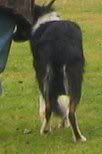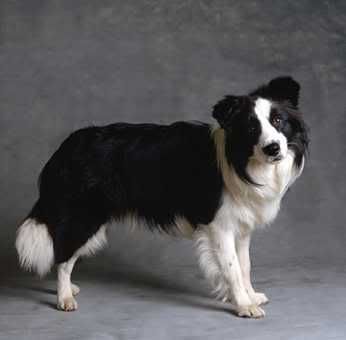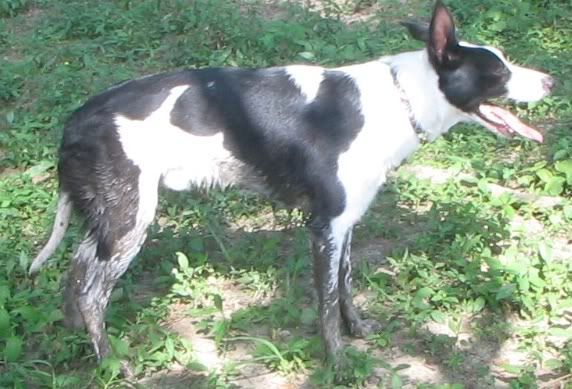a gray border collie
Actually, this is even an "acceptable" color in the AKC standard - any color is acceptable other than solid white. It's hard to win with a non-black and white, non-rough coat, however.
While this isn't bad.... what is the point of saying you have a BC (or
any breed) if it doesn't conform to the standard? They are bred to be
recognizable. That's why you have purebred dogs, bred for a specific
function... which requires a specific look (due to the requirements of
their job.
This is where we differ from the conformation people. We disagree that it takes a certain look to do the job. In fact, what happens is that the job has defined the dog, and absolutely nothing else. Amazingly, though there has been NO "standard" for the British or American Border Collie for its entire history, it's still a pretty easy to identify dog.
You might look at one of my friend's dogs in the pound and not be able to see he or she is a Border Collie for sure. But that's not what matters to us. Who cares if you don't know that my dog is a Border Collie just by looking? What matters is that my minimally trained young dog can stop hungry sheep from entering my neighbors' vegetable gardens:

Breeding for "the look" first puts the cart before the horse for us. There's no way to predict the body type that will function correctly under the complex extremes the dogs undergo. Yes, hunting's tough, but I'm fairly sure that the dogs aren't regularly required to do stuff like this:



The little twist at the end of the above sequence is evident in all of these pictures. It looks like the dog is inviting the sheep to dance, but what they are all doing, is relieving pressure the second the sheep "gives in." Ted's having a bit of trouble (first picture) unlocking his eye, but his shoulder's giving out.
Even on my little farm, Ted's constantly having to do stuff like this. Actually, if you look at my siggy, you'll see not one of the dogs is straight up and down, or single tracking.
This is Ted. Tell me that a judge would NOT first shudder, then dismiss him with a laugh.


You've seen what the second dog above looks like as a youngster - he's in the "Twist pups" group. Imagine you are a breed judge, and most of the dogs look like this:

And my friend brings in her dog that looks like this (obviously cleaned up - he cleans up nicely, LOL):

People who think it's "easy" to have a show dog, would not believe the
amount of training that goes into it. Someone who'd never been to a
dog show showed up at the Weim Nationals, they were shocked at the
sheer number of intact males in the same vicinity (just inches away
from each other at some points) who showed no aggression, standing
perfectly still, moving on lead at a gait versus loping or pacing.
Those who decided to cull the show dog from the working registry are well aware of this. The two pursuits in many ways reward diametrically opposing traits. You can't always train every dog to do every possible discipline. And experience has shown those who developed the Border Collie, and continue to maintain the breed, that conformation showing is incompatible with maintaining a high standard of working ability in the breed.
None of this is to say that we do not have a breed standard. We do. It's a performance standard. You can find a description here: National trials sheepdog course.
Here's a little picture illustration:

400 yards to the sheep is a minimum by the way. There are shorter courses, but the trials that really mean anything fall into the above description.
To become a "Champion" a dog will have to complete a course twice as long, work with four times as many sheep, and complete a complicated sorting exercise.
These courses are intensely grueling, both physically and mentally. These are dogs that work six hours days and come back and are game for a walk or frisbee. But once or twice around these courses and they want to snooze in the crate the rest of the day!!
So we train for the job and let the "form" take care of itself. The Border Collie has, until recently, been incredibly low in health issues in the breed. Frankly, the issues we see today have crept in due to a few generations of less focus on function and less than honest breeding decisions - breeding dogs that don't truly do a real day's work day after day.
Interestingly, the show lines have at least two, and possibly three issues that are unknown in the working lines. Two of these three are fatal conditions, sadly.